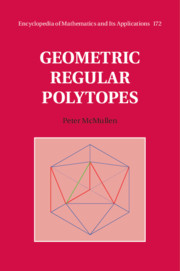Book contents
- Frontmatter
- Contents
- Foreword
- I Regular Polytopes
- II Polytopes of Full Rank
- III Polytopes of Nearly Full Rank
- 9 General Families
- 10 Three-Dimensional Apeirohedra
- 11 Four-Dimensional Polyhedra
- 12 Four-Dimensional Apeirotopes
- 13 Higher-Dimensional Cases
- IV Miscellaneous Polytopes
- Afterword
- Bibliography
- Notation Index
- Author Index
- Subject Index
11 - Four-Dimensional Polyhedra
from III - Polytopes of Nearly Full Rank
Published online by Cambridge University Press: 30 January 2020
- Frontmatter
- Contents
- Foreword
- I Regular Polytopes
- II Polytopes of Full Rank
- III Polytopes of Nearly Full Rank
- 9 General Families
- 10 Three-Dimensional Apeirohedra
- 11 Four-Dimensional Polyhedra
- 12 Four-Dimensional Apeirotopes
- 13 Higher-Dimensional Cases
- IV Miscellaneous Polytopes
- Afterword
- Bibliography
- Notation Index
- Author Index
- Subject Index
Summary
As in the case of the 3-dimensional regular apeirohedra described in the previous chapter, the mirror vector plays an important role in the classification of the 4-dimensional regular polyhedra. Thus the first task is to determine the possible mirror vectors of such polyhedra. The polyhedra with mirror vector (3,2,3) and their relatives under standard operations such as Petriality form a specially rich family. One particular family of these polyhedra is treated in detail, with a description of their realization domains. With the mirror vector (2,3,2), most of the standard operations lead to polyhedra in the same class. Though there is a close analogy between the infinite and finite cases, those with mirror vector (2,2,2) have symmetry groups that need not be related to reflexion groups; the treatment here employs quaternions. There are various connexions among these regular polyhedra, the most interesting being the way that the skewing operation takes certain polyhedra in class (3,2,3) into polyhedra of class (2,2,2).
- Type
- Chapter
- Information
- Geometric Regular Polytopes , pp. 383 - 430Publisher: Cambridge University PressPrint publication year: 2020

